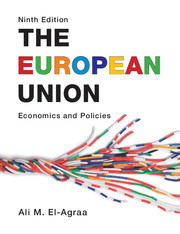Book contents
- Frontmatter
- Contents
- Figures
- Tables
- Boxes
- Contributors
- Preface
- A reader’s guide
- Abbreviations
- 1 General introduction
- Part I EU history, institutions and legal dimension
- Part II EU market integration
- Part III EU monetary integration
- Part IV The single European market
- Part V EU budget and structural policies
- 19 The general budget
- 20 The Common Agricultural Policy
- 21 The Common Fisheries Policy
- 22 Regional policy
- 23 Social policies
- Part VI EU external relations
- Part VII The future of the EU
- Bibliography
- Author Index
- Index
- References
21 - The Common Fisheries Policy
from Part V - EU budget and structural policies
- Frontmatter
- Contents
- Figures
- Tables
- Boxes
- Contributors
- Preface
- A reader’s guide
- Abbreviations
- 1 General introduction
- Part I EU history, institutions and legal dimension
- Part II EU market integration
- Part III EU monetary integration
- Part IV The single European market
- Part V EU budget and structural policies
- 19 The general budget
- 20 The Common Agricultural Policy
- 21 The Common Fisheries Policy
- 22 Regional policy
- 23 Social policies
- Part VI EU external relations
- Part VII The future of the EU
- Bibliography
- Author Index
- Index
- References
Summary
The tables referred to in this chapter can be found online at www.cambridge.org/el-agraa
Introduction
The Common Fisheries Policy (CFP) illustrates both the potential and the limitations of EU policy. Fisheries are an inherently difficult sector to manage. Issues such as competing views on property rights and tensions between scientists, fishers and conservationists are well known in fishing communities across the world. The crisis in most major fish stocks has heightened tensions in debates over the conservation and management of stocks. Key aspects of the sector, such as trade, processing and ownership, are becoming increasingly internationalized, but this has been a difficult process in a sector where individualism and a strong sense of community run deep. One of the challenges for fishery regimes is to compete effectively in the global market, but at the same time to cushion communities from social costs and economic decline.
- Type
- Chapter
- Information
- The European UnionEconomics and Policies, pp. 335 - 347Publisher: Cambridge University PressPrint publication year: 2011



